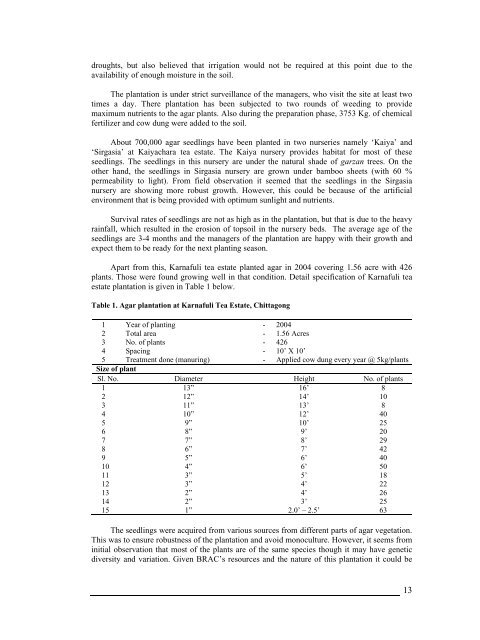Agarwood Plantation at BRAC Tea Estate - BRAC Research and ...
Agarwood Plantation at BRAC Tea Estate - BRAC Research and ...
Agarwood Plantation at BRAC Tea Estate - BRAC Research and ...
You also want an ePaper? Increase the reach of your titles
YUMPU automatically turns print PDFs into web optimized ePapers that Google loves.
droughts, but also believed th<strong>at</strong> irrig<strong>at</strong>ion would not be required <strong>at</strong> this point due to theavailability of enough moisture in the soil.The plant<strong>at</strong>ion is under strict surveillance of the managers, who visit the site <strong>at</strong> least twotimes a day. There plant<strong>at</strong>ion has been subjected to two rounds of weeding to providemaximum nutrients to the agar plants. Also during the prepar<strong>at</strong>ion phase, 3753 Kg. of chemicalfertilizer <strong>and</strong> cow dung were added to the soil.About 700,000 agar seedlings have been planted in two nurseries namely ‘Kaiya’ <strong>and</strong>‘Sirgasia’ <strong>at</strong> Kaiyachara tea est<strong>at</strong>e. The Kaiya nursery provides habit<strong>at</strong> for most of theseseedlings. The seedlings in this nursery are under the n<strong>at</strong>ural shade of garzan trees. On theother h<strong>and</strong>, the seedlings in Sirgasia nursery are grown under bamboo sheets (with 60 %permeability to light). From field observ<strong>at</strong>ion it seemed th<strong>at</strong> the seedlings in the Sirgasianursery are showing more robust growth. However, this could be because of the artificialenvironment th<strong>at</strong> is being provided with optimum sunlight <strong>and</strong> nutrients.Survival r<strong>at</strong>es of seedlings are not as high as in the plant<strong>at</strong>ion, but th<strong>at</strong> is due to the heavyrainfall, which resulted in the erosion of topsoil in the nursery beds. The average age of theseedlings are 3-4 months <strong>and</strong> the managers of the plant<strong>at</strong>ion are happy with their growth <strong>and</strong>expect them to be ready for the next planting season.Apart from this, Karnafuli tea est<strong>at</strong>e planted agar in 2004 covering 1.56 acre with 426plants. Those were found growing well in th<strong>at</strong> condition. Detail specific<strong>at</strong>ion of Karnafuli teaest<strong>at</strong>e plant<strong>at</strong>ion is given in Table 1 below.Table 1. Agar plant<strong>at</strong>ion <strong>at</strong> Karnafuli <strong>Tea</strong> Est<strong>at</strong>e, Chittagong1 Year of planting - 20042 Total area - 1.56 Acres3 No. of plants - 4264 Spacing - 10’ X 10’5 Tre<strong>at</strong>ment done (manuring) - Applied cow dung every year @ 5kg/plantsSize of plantSl. No. Diameter Height No. of plants1 13” 16’ 82 12” 14’ 103 11” 13’ 84 10” 12’ 405 9” 10’ 256 8” 9’ 207 7” 8’ 298 6” 7’ 429 5” 6’ 4010 4” 6’ 5011 3” 5’ 1812 3” 4’ 2213 2” 4’ 2614 2” 3’ 2515 1” 2.0’ – 2.5’ 63The seedlings were acquired from various sources from different parts of agar veget<strong>at</strong>ion.This was to ensure robustness of the plant<strong>at</strong>ion <strong>and</strong> avoid monoculture. However, it seems frominitial observ<strong>at</strong>ion th<strong>at</strong> most of the plants are of the same species though it may have geneticdiversity <strong>and</strong> vari<strong>at</strong>ion. Given <strong>BRAC</strong>’s resources <strong>and</strong> the n<strong>at</strong>ure of this plant<strong>at</strong>ion it could be13















![[re-tender] RFQ for supply of Diesel Generator - Brac](https://img.yumpu.com/44421374/1/186x260/re-tender-rfq-for-supply-of-diesel-generator-brac.jpg?quality=85)
